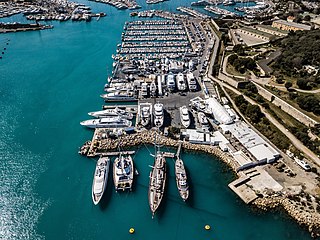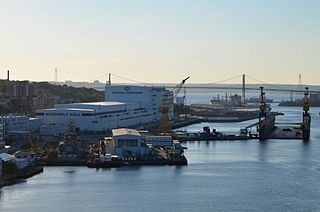Related Research Articles

A shipyard, also called a dockyard or boatyard, is a place where ships are built and repaired. These can be yachts, military vessels, cruise liners or other cargo or passenger ships. Compared to shipyards, which are sometimes more involved with original construction, dockyards are sometimes more linked with maintenance and basing activities. The terms are routinely used interchangeably, in part because the evolution of dockyards and shipyards has often caused them to change or merge roles.
Naval Group is a major French industrial group specializing in naval defense design, development and construction. Its headquarters are located in Paris.

The Royal Malaysian Navy is the naval arm of the Malaysian Armed Forces. RMN is the main agency responsible for the country's maritime surveillance and defence operations. RMN's area of operation consists of 603,210 square kilometers covering the country's coastal areas and Exclusive Economic Zones (EEZ). RMN also bears the responsibility of controlling the country's main Sea Lines of Communications (SLOC) such as the Straits of Malacca and the Straits of Singapore and also monitors national interests in areas with overlapping claims such as in Spratly.

The Zwaardvis-class submarine ("Swordfish") is a class of conventional attack submarines that were built to strengthen the Royal Netherlands Navy. The Dutch government opted for the choice to not replace the two Zwaardvis-class submarines with either more Walrus-class submarines, or submarines of a new design.

The Kedah-class offshore patrol vessels of the Royal Malaysian Navy (RMN) are six ships based on the MEKO 100 design by Blohm + Voss. Originally, a total of 27 ships were planned, but due to programme delays and overruns, only six were eventually ordered. Their construction began in the early 2000s, and by 2009, all six were in active service. The six vessels are named after Malaysian states.
The German Naval Group is a consortium of German industrial companies that bid and won a major contract to design and build the New Generation Patrol vessels (NGPV) for the Royal Malaysian Navy.

The Rotterdamsche Droogdok Maatschappij (RDM) was the largest pre-World War II shipbuilding and repair company in Rotterdam in the Netherlands, existing from 1902 to 1996. It built 355 mostly major seagoing vessels, 18 of which were submarines. During its existence, the wharf operated 12 floating docks and in its heyday employed 7,000 people at one time.

The Halifax Shipyard Limited is a Canadian shipbuilding company located in Halifax, Nova Scotia.
Damen Naval is a Dutch shipyard, and a continuation of the Koninklijke Maatschappij De Schelde, responsible for a number of ships used by the Royal Netherlands Navy. It is owned by the Damen Group. Damen Naval is situated in Vlissingen.

The Maharaja Lela-class frigate, also known as the Littoral Combat Ship (LCS), is a class of six stealth frigates being built for the Royal Malaysian Navy (RMN). First announced as the Second Generation Patrol Vessel (SGPV) in 2011, the ships are based on an enlarged version of the Gowind-class corvette, designed by Naval Group, formerly known as DCNS of France.

Boustead Heavy Industries Corporation Berhad, often abbreviated as BHIC is a Malaysian industrial group specialised in defence, naval and commercial shipbuilding, ship repair, fabrication of offshore structures as well as maintenance, repair and overhaul of aircraft. The company is a public limited company and the largest shareholder is Armed Forces Fund Board, a government statutory body which provides retirement benefits and a savings scheme for officers of the Malaysian Armed Forces, with a 58.69% stake. The second largest shareholder is Retirement Fund (Incorporated), a company created by the Malaysian Government as an investment company, with a stake of 7.17%.

Labuan Shipyard and Engineering (LSE) is a Malaysian shipbuilding company based in the East Malaysian island of Federal Territory of Labuan, Malaysia. It is the biggest shipyard in Borneo.

HNLMS Poolster was a replenishment ship serving with the Royal Netherlands Navy. Poolster entered service on 29 June 1964. In 1994 she was decommissioned and sold to the Pakistan Navy where the ship was renamed Moawin. A later replenishment ship Zuiderkruis was based on Poolster. In the Dutch navy she was replaced by the replenishment ship Amsterdam. She was the first ship in the Dutch navy with inbuilt protection against radioactive fallout.
The Sri Tiga class is a class of fast troop vessels of the Royal Malaysian Navy (RMN) with the length of 38 meters and displacing 117 tons. A total of two ships are currently in service.

KA Tun Azizan is an auxiliary ship currently in service with Royal Malaysian Navy (RMN). She was sponsored by local company Petroliam Nasional Berhad (PETRONAS) and transferred from Malaysia International Shipping Corporation Berhad (MISC) to the RMN. Malaysia Marine and Heavy Engineering (MMHE) then changes and modifies a used cargo vessel to be used as a forward operation base operated by the Royal Malaysian Navy in Sulu Sea, Lahad Datu, Sabah to support the operation of the Eastern Sabah Security Command (ESSCOM). Since its operation in July 2015, KA Tun Azizan has operated under the Malaysian International Shipping Corporation (MISC) with the appointment of commanding officers absorbed as members of the RMN Volunteer Reserve Team.
Multi-Role Support Ship (MRSS) is a class of amphibious ship planned for the Royal Malaysian Navy (RMN).

KD Syarif Masahor is the second ship of Maharaja Lela-class frigate built locally by Boustead Heavy Industries Corporation (BHIC). She build based on enlarged version of Naval Group's Gowind-class design. The ship named after Syarif Masahor, in honour of the Sarawak warrior during British colonialism.
Lumut Naval Shipyard (LUNAS) is a shipbuilding company owned by Malaysia. This company is located in Lumut, Perak which is one of the Royal Malaysian Navy (RMN) bases and has several other shipyards throughout Malaysia. The main business of LUNAS is the maintenance and manufacturing of ships as well as the construction of heavy engineering structures and offshore structures.

Boustead Tower, formerly known as PSCI Tower, is an office building within George Town in the Malaysian state of Penang. Located at Northam Road within the city's Central Business District (CBD), the 21-storey building was completed in 1994. It was sold to Boustead Holdings in 2006. Apart from Boustead, IWG plc is one of the major tenants of the tower.